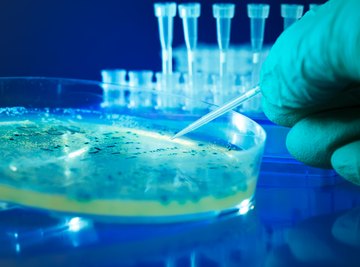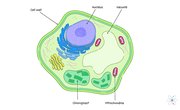
Living organisms are made up of microscopic units called cells. The cells for animals, plants, fungi and bacteria have many similarities, and some fundamental differences. All living cells have cytoplasmic membranes, but animal cells do not have cell walls, and plant and bacterial cells do. The molecular structure and function of plant cell walls, however, is distinctly different from the structure and function of bacterial cell walls.
TL;DR (Too Long; Didn't Read)
The molecular structure and function of plant cell walls is distinctly different from the structure and function of bacterial cell walls. Plant cells have two kinds of cell walls, which serve different functions. The primary cell wall provides flexible structure and support as plant cells grow and divide. The secondary cell wall appears when the plant cell has finished growing to supply rigid support. A bacterial cell wall protects the cell from bursting and from attack and contamination.
Primary Plant Cell Walls
Plant cells have two kinds of cell walls, which serve different functions. The plant cell’s primary wall provides structure and support as the plant cells grow and divide. The primary cell wall plays a part in the plant’s size and shape, and it protects the cells from over-expanding. When fruits and vegetables ripen, the primary cell walls change in structure and chemical makeup. Some of the most prominent components of the primary cell wall are proteins called expansins, which regulate cell wall expansion, and a number of polysaccharides – complex carbohydrate molecules – such as cellulose, hemicellulose and pectin.
Secondary Plant Cell Walls
Secondary plant cell walls begin to appear between primary cell walls and plasma membranes only after the cell has finished growing. Their compositions and functions vary significantly depending on the plant species and the type of cell. Secondary cell walls tend to be much thicker than primary cell walls and provide even more strength and structure to the plant. They are rigid and do not have the flexibility required of primary cell walls because cell growth has already ceased.
Like primary cell walls, secondary cell walls contain polysaccharides, although in different proportions. The secondary cell walls of many grasses and woody plant tissues contain mostly cellulose and hemicellulose, including a form of hemicellulose called xylan, which makes up approximately a third of the secondary walls’ mass in these types of cells. Unlike primary cell walls, secondary cell walls also contain a molecule called lignin, which provides additional structure and strength.
Bacterial Cell Wall Function
Bacteria cell walls provide structure like plant cell walls. Unlike plant cell walls, however, the bacterial cell wall is responsible only for the one-celled organism itself, without the requirement of connecting and supporting a larger organism composed of many cells. Bacterial cell walls are rigid and protect the cells from outside contaminants, as well as from bursting if the surrounding environment’s osmotic pressure is very different from that inside the cell. Some bacteria have appendages like flagella, which help the cell move or stay put. These appendages are anchored in the cell walls for stability.
Bacterial Cell Wall Structure
Cell walls are primarily composed of a polysaccharide called peptidoglycan, although the cell walls differ greatly between bacteria species, particularly in their structures. They surround and protect the cell’s cytoplasmic membrane, which is a thin layer of proteins and phospholipids that are selective about what they allow to enter and exit the cells. Some bacterial cells also have a capsule surrounding the cell wall. This is an even more rigid structure made of polysaccharides that protects the cell from drying out. Together, these two or three layers – depending on the bacterial species – are called the cell envelope.
References
About the Author
Rebecca E. received a degree in human development before attending graduate school in writing. She has an extensive background in cognition and behavior research, particularly the neurological bases for personality traits and psychological illness. As a freelance writer, her specialty is science and medical writing. She's written for Autostraddle, The Griffith Review and The Sycamore Review.
